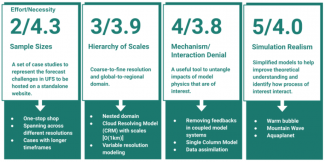Despite significant improvement of model development and computational resources, model forecast issues still exist in numerical weather prediction (NWP) and Earth system models (ESMs), including the Unified Forecast System (UFS). Hierarchical System Development (HSD) (Ek et al. 2019) is an efficient approach for model development, enabling the community with multiple entry points for research efforts, spanning simple processes to complex systems. It accelerates research-to-operations-to-research (R2O2R) by facilitating interactions between a broad scientific community and the operational community.
The Developmental Testbed Center (DTC), in collaboration with the Earth Prediction Innovation Center (EPIC), prepared a white paper describing a long-term vision of HSD for the UFS and a plan for its phased implementation. This paper outlines proposed hierarchical axes relevant to the UFS, HSD capabilities that currently exist in the UFS, and recommendations for future development by EPIC aligned with each axis. A survey on HSD for UFS was distributed to a broad research and operational community to collect valuable insight and feedback on participants' experience with, and use of, HSD tools, testing infrastructure, current and future capability needs, and perceived gaps to help inform the future HSD within the UFS. The results were used to inform the white paper and prioritize the proposed recommendations.
Several unique perspectives exist for this topic, where hierarchical systems have been defined by axes such as model complexity (Bony et al. 2013), model configuration (Jeevanjee et al. 2017), or principles of large-scale circulations (Maher et al. 2019). Building upon these perspectives, the white paper introduces four main axes that can be applied to the UFS framework. The first discusses sample size, where the common approach during the model issue-identification stage is to start from one case study and expand to multiple similar cases to determine any systematic biases. The second is hierarchy of scales, spanning coarse-to-fine grid spacing and global-to-regional scales, including dynamic downscaling techniques such as nesting and variable resolution modeling. The third is simulation realism, which refers to the simplification of models to help improve theoretical understanding of atmospheric processes and interactions. The fourth is mechanism/interaction denial, where the model can be configured such that any given mechanism(s) can be turned off in place of data models to examine the impact of specific mechanisms on atmospheric or other model component processes.
Key recommendations, as well as level of effort and necessity within each of the axes, were then prioritized to help inform the future progress of the UFS HSD (Fig. 1). To address sample size, a compilation of case studies that represent model issues is recommended to be developed and maintained to help facilitate development and improvement of modeling systems. These cases should span from single cases to multiple similar cases, and from short-term runs to long-term runs. The priority for hierarchy of scales is to include the current capabilities of nesting in publicly released applications and to establish sub-3-km capabilities. Mechanism/interaction denial recommendations include continued enhancements to the Common Community Physics Package Single Column Model (CCPP-SCM), capabilities for removing feedback in a coupled model system, such as CDEPS, and continued development of data assimilation. A highly configurable framework for idealized simulations is desired for simulation realism.
The vision and ongoing development for the HSD testing framework by the EPIC team, in collaboration with the UFS community, is to accelerate the research and development capabilities of the UFS and to facilitate the day-to-day development work for the UFS. This will increase the readiness of the UFS and its applications for releases and deployments.
References
Bony, S., and Coauthors, 2013: Monograph on Climate Science for Serving Society: Research, Modelling and Prediction Priorities.
Ek, M., and coauthors, cited 2023: Hierarchical System Development for the UFS. [Available online at https://ufscommunity.org/articles/hierarchical-system-development-for-the-ufs/.]
Jeevanjee, N., P. Hassanzadeh, S. Hill, and A. Sheshadri, 2017: A perspective on climate model hierarchies. Journal of Advances in Modeling Earth Systems, 9, 1760-1771, https://doi.org/10.1002/2017MS001038.
Maher, P., and Coauthors, 2019: Model Hierarchies for Understanding Atmospheric Circulation. Reviews of Geophysics, 57, 250-280, https://doi.org/10.1029/2018RG000607.
